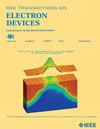Investigation of TID and DD Effects on FD SOI Nanowire FET Induced by Proton Irradiation
IF 2.9
2区 工程技术
Q2 ENGINEERING, ELECTRICAL & ELECTRONIC
引用次数: 0
Abstract
In this study, radiation-induced degradation, which is caused by total ionizing dose (TID) and displacement defect (DD) effect, is investigated in fully depleted silicon-on-insulator (FD SOI) nanowire field-effect transistors (NWFETs) under 25-MeV proton irradiation. The combined effect of TID and DD degraded the subthresh old swing (SS) and质子辐照诱导FD SOI纳米线场效应管的TID和DD效应研究
在本研究中,研究了25 mev质子辐照下全耗尽绝缘体上硅(FD SOI)纳米线场效应晶体管(nwfet)中总电离剂量(TID)和位移缺陷(DD)效应引起的辐射诱导降解。TID和DD的联合作用降低了n型FD SOI nwfet的亚阈值旧摆幅(SS)和关断电流(Ioff),同时降低了p型FD SOI nwfet的阈值电压(Vth)和导通电流(Ion)。这种降解对质子通量的增加很敏感。此外,随着栅极长度(Lg)的减小,由DD效应引起的降解增加,并且由于TID和DD的联合作用而加剧了降解。然而,具有改进侧栅极控制的窄器件减轻了界面陷阱、氧化物陷阱、隔离器中捕获的正电荷和DD的影响。
本文章由计算机程序翻译,如有差异,请以英文原文为准。
求助全文
约1分钟内获得全文
求助全文
来源期刊

IEEE Transactions on Electron Devices
工程技术-工程:电子与电气
CiteScore
5.80
自引率
16.10%
发文量
937
审稿时长
3.8 months
期刊介绍:
IEEE Transactions on Electron Devices publishes original and significant contributions relating to the theory, modeling, design, performance and reliability of electron and ion integrated circuit devices and interconnects, involving insulators, metals, organic materials, micro-plasmas, semiconductors, quantum-effect structures, vacuum devices, and emerging materials with applications in bioelectronics, biomedical electronics, computation, communications, displays, microelectromechanics, imaging, micro-actuators, nanoelectronics, optoelectronics, photovoltaics, power ICs and micro-sensors. Tutorial and review papers on these subjects are also published and occasional special issues appear to present a collection of papers which treat particular areas in more depth and breadth.
 求助内容:
求助内容: 应助结果提醒方式:
应助结果提醒方式:


